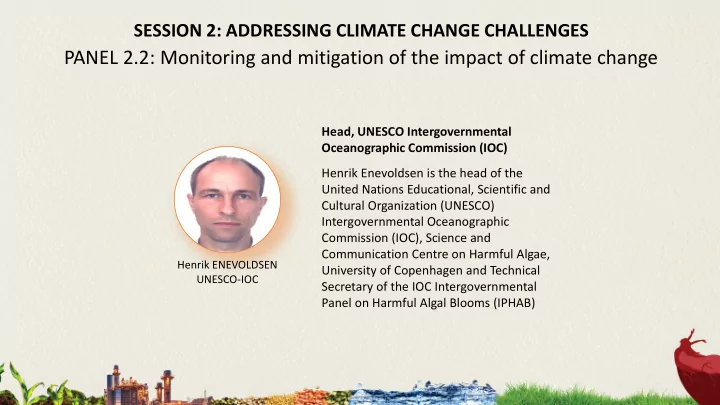

SESSION 2: ADDRESSING CLIMATE CHANGE CHALLENGES PANEL 2.2: Monitoring and mitigation of the impact of climate change Head, UNESCO Intergovernmental Oceanographic Commission (IOC) Henrik Enevoldsen is the head of the United Nations Educational, Scientific and Cultural Organization (UNESCO) Intergovernmental Oceanographic Commission (IOC), Science and Communication Centre on Harmful Algae, Henrik ENEVOLDSEN University of Copenhagen and Technical UNESCO-IOC Secretary of the IOC Intergovernmental Panel on Harmful Algal Blooms (IPHAB)
IAEA Ministerial Conference on Science and Technology: Addressing Current and Emerging Development Challenges Panel 2.2: Monitoring and mitigation of the impact of climate change Challenges for monitoring of biotoxins in relation to seafood safety and the related needs for capacity development Henrik Enevoldsen Intergovernmental Oceanographic Commission of UNESCO IOC Science and Communication Centre on Harmful Algae Jacob Larsen - UCPH, Marie-Yasmine Dechraoui Bottein - IAEA/EL, Eileen Bresnan - Marine Scotland
Human Health, Wellbeing and Economy Living marine resources Food , Energy, Leisure/Tourism , Economic Development Top carnivorous Carnivorous consumers Herbivorous consumers ▪ At the basis of the Primary producers Phytoplankton: marine food web, and key food item in or micro-algae aquaculture ▪ ~2% of the thousands of species are harmful and/or toxic
What is harmful algae? • Some single celled micro-algae in the marine environment produce toxins. Some cause harm due to their biomass. • A natural phenomena • Increase in severity of HAB events Microalgae Blooms Toxic or dead seafood
World total (2015) Capture: 92.6 million tonnes Aquaculture: 106 million tonnes FAO. 2016. The State of World Fisheries and Aquaculture 2016. Contributing to food security and nutrition for all. Rome. 200 pp. FAO, 2017. FAO Global Capture Production database updated to 2015 - Summary information.
Harmful algal event impacts • Directly affect almost all coastal states • Contaminates seafood, threatening public health and industries • Kill wild and farmed fish; aquaculture impacts likely to increase with growth of industry • Threaten drinking water supplies from desalination • With rapidly growing populations in coastal areas and reliance on aquaculture, global economic and human health impacts of toxic microalgae are chronic and widespread
Challenges: Number of species known to produce • Number of known toxic species increase toxins impacting on seafood safety and security and humans, as listed in the IOC- UNESCO Taxonomic Reference List of Harmful Micro Algae (Moestrup et al. 2002- 2018). • Number of known toxins increase Timeline of discovery of the major categories of phycotoxins (modified after Hess 2008). • Challenges monitoring and management • Require development of new technology and methods
And what may climate/global change imply? . Environment Biology The progression of climate change pressure on key variables and related HAB interactions that will drive HAB responses in the future ocean. (Wells et a l, 2015)
And what may climate change imply? • Several types of Harmful Algal events • - some will increase others decrease • BUT, those most harmful are likely to increase! A general overview of the current understanding from the literature of how different HAB types will be affected by climate change stressors. Arrows indicate changes that either increase, decrease, or • The need for management and mitigation can occur in both directions. Symbols suggest the will increase level of confidence: + (reasonably likely), ++ (more likely). (Wells et a l, 2015)
Priority is to protect of public health and secure safe seafood : • Enhance capacity in countries to mitigate the effects of harmful algal events; • Cooperative research to better understand key environmental parameters that control harmful algal events; • Strengthen or develop regional networks for early warning of HABs and biotoxins in seafood • Method validation and acceptance (CODEX, EU, USFDA etc), provision of reference material • Improve data collection, reporting and assessments Sustainability Public health Safe seafood
Specific IAEA initiatives: • In 2018, TC projects involve more than half of IAEA coastal Member States • 49 countries, all regions trained on sampling and identification of toxic D e v e lo p in g M e m b e r S ta te s re ce ivin g phytoplankton and 18 equipped for toxin 6 0 T e c h n ic a l C o o p e ra tio n s u p p o rt fo r H A B s C u m u la te d n u m b e r o f M S s detection* 5 0 4 0 A ll m a rin e H A B s 3 0 • Increasing demand from developing B H A B s 2 0 countries to address HABs and biotoxins 1 0 0 1 9 9 7 1 9 9 8 2 0 0 0 2 0 0 2 2 0 0 5 2 0 0 7 2 0 0 9 2 0 1 0 2 0 1 4 2 0 1 6 2 0 1 8 *Receptor Binding Assay, a nuclear technique Y e a r
IAEA – IOC UNESCO initiatives Production of training material and manuals
Joint IOC-IAEA-FAO-WHO Ciguatera Strategy - Guidance to Local Communities - Guidelines on ciguatera poisoning management - WHO-FAO Codex Alimentarius Guidance for ciguatoxin contamination in food 13
IOC UNESCO is with partners IAEA, ICES, PICES and ISSHA developing the first Global HAB Status Report -Will be an input to the World Ocean Assessment, IPCC, and other global assessments Partitioning of 4528 global HAEDAT events into seafood toxins, high biomass water discolorations, fauna mass mortalities , and the further breakdown of seafood toxins into DSP, PSP, ASP, NSP, CFP, AZP and cyanotoxins. Data as of 1/3/2017. Compiled by L. Schweibold & G.Hallegraeff.
The IAEA plays a key role in all this work to ensure: • sustainable and safe seafood production • efficient monitoring strategies to reduce human health and environmental impacts due to biotoxins and HABs • and hence contribute to achieve SDGs
Thank you for your attention
Recommend
More recommend